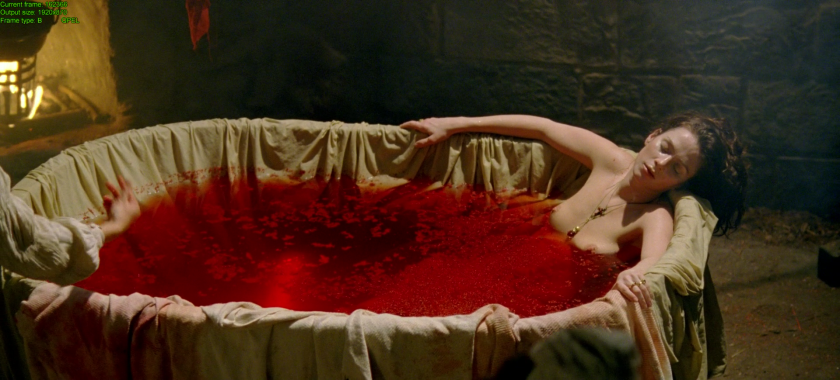
According to the Guinness Book of World Records, the most prolific female murderer of all time was Elizabeth Báthory, a 16th-century Hungarian noblewoman. She is said to have murdered over 600 young women, practising vampirism and bathing in their blood to preserve her own youth and beauty.
Now I don’t know what the verification process is for the Guinness Book of records (it’s been a long time since my own unsuccessful attempt to build the world’s largest pyramid out of empty beer cans) but this seems like an iffy one to me. Many of the testimonies were based on hearsay from superstitious bumpkins or extracted from “witnesses” by torture. The exact kill count is thought to be greatly exaggerated.

Buy your copy of Bathory: Countess of Blood from Amazon HERE
Going to bat for poor old Elizabeth is veteran Slovak director Juraj Jakubisko with Bathory: Countess of Blood, an expensively mounted Czech, Slovak, Hungarian and British co-production. Setting out its stall as a revisionist historical epic, the movie veers wildly between horror, political intrigue and bodice-ripping romance, with some wacky comic touches thrown in for good measure – monks on clockwork rollerskates, for example.
In short, it’s a pretty kooky way to try clearing someone’s name, as Jakubisko attempts to rescue Báthory from the naughty step of history by spinning his own unreliable yarn…
Erzsébet Báthory (Anna Friel) is left behind in her castle (Čachtice, now in present-day Slovakia) while her husband Ferenc (Vincent Regan) is away fighting the Ottomans. She is given the gift of a hunky young Italian painter, Merisi (Hans Matheson), who was captured from the enemy. The artist, who turns out to be Caravaggio, is set to work painting the portrait of Báthory and her two children. The countess is lonely and starts having an affair with him.
For some reason I didn’t quite catch, the Countess is into natural healing, herbal remedies and performing amateur autopsies on corpses in the dungeon beneath her castle, which of course won’t look good when all the accusations of vampirism and witchcraft start flying around later in the movie.
The plot thickens when Ferenc’s war buddy and neighbouring nobleman Thurzó (Karel Roden) makes clear his designs on their land and Báthory herself. After the Countess is accidentally poisoned, she is cured by a local healer with a reputation as a witch, Darvulia (Deana Jakubisková-Horváthová), which only serves to intensify her association with the dark arts in the minds of the superstitious locals.

After Ferenc’s death, Thurzó continues his pursuit of Báthory and her assets As she resists, he plots to destroy her by gathering conspirators to help incriminate her for murder and witchcraft…
Jakubisko conjures up an entertainingly gory and lascivious vision of 16th century Hungary, with tortured flesh, severed heads and naked bodies everywhere. There is some impressive costume design and the money seems like it’s all up there on the screen. Unfortunately, F. A. Brabec (Wild Flowers) is listed as one of the cinematographers, which means the film sometimes looks a little like a Meatloaf video from the early ’90s (“I would do anything for blood”… anyone?)
Anna Friel replaced Famke Janssen in the lead role, and hers is a feisty but romanticized portrayal of the gloomy, pale, cruel Countess of myth and legend. She puts in a determined performance, but she’s a little too bland to be compelling as a misunderstood figure of horror. The original casting choice of Janssen would have been intriguing. Personally, I think the part would’ve been perfect for someone like Chloë Sevigny.

Other than Friel, Karel Roden puts in a solid shift as the scheming, scowling Thurzó, and Czech legend Bolek Polivka appears as the monk, Petr, who narrates the tale. Petr is sent to spy on Báthory, helped by his young assistant and a vast array of improbable inventions such as the previously mentioned rollerskates, cat-powered electricity, microphones, and others.
He’s a bit like a Renaissance-era Inspector Gadget, and his baffling presence undermines the film’s credibility somewhat. As does Bathory’s fling with a young Caravaggio, which leads to another questionable moment involving a quick knee-trembler in a confession box…
Bathory: Countess of Blood is a pretty zany mess of a movie, and it could’ve done with someone more exciting than Anna Friel to cut their own distinctive swath through all the splashy production design. The one thing you can say is that it certainly isn’t boring, which was my concern sitting down to the film. I just wish it was a little bit worse, a little darker and weirder, to really tip it over into so-bad-it’s-good territory, but unfortunately it never goes quite far enough.
I had a crack at this a couple of months back, since the asubject interest me; this was a big film for Czech audiences at the time of release, I think?
LikeLike
Hey, it was an expensive movie and didn’t make its money back at the box office. It holds a 55% approval rating on CSFD (the Czech-Slovak IMDb) which I think is understandable… didn’t you get on with it very well?
LikeLiked by 1 person
I maybe wasn’t in the mood, but I like the version of this story in Immoral Tales, and I’ll give it another spin…
LikeLike
Yeah let me know how you get on if you do give it another try!
LikeLike
This isnt even a czech film…
LikeLike
It’s a Czech, Slovak, Hungarian and British co-production, so it’s close enough for the purpose of this blog!
LikeLiked by 1 person